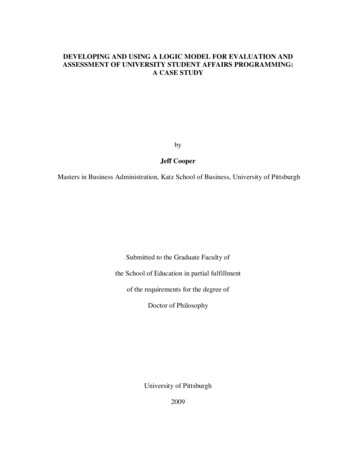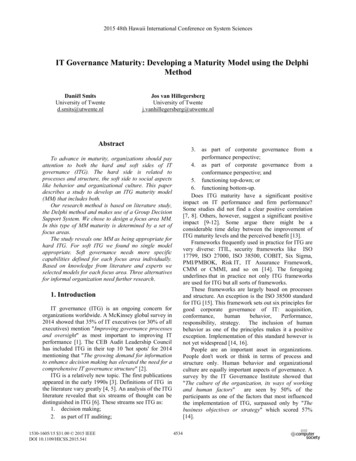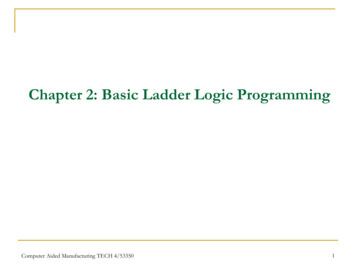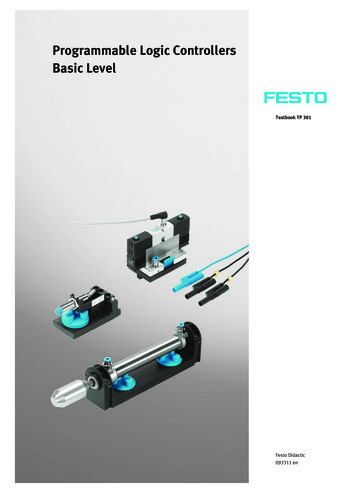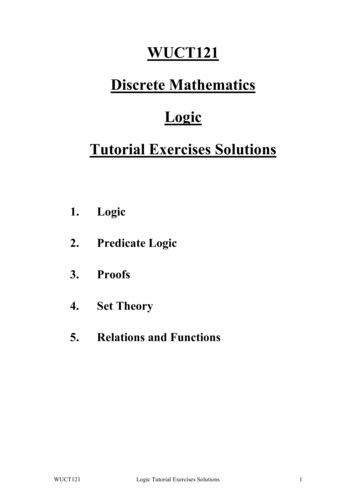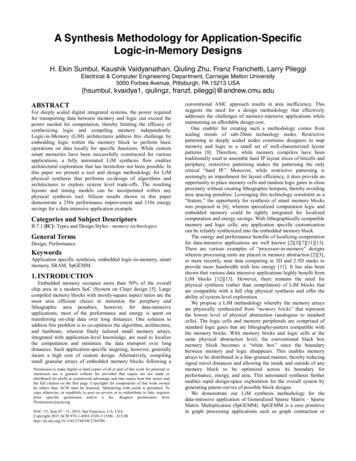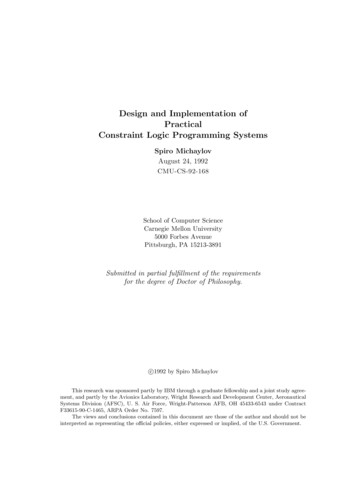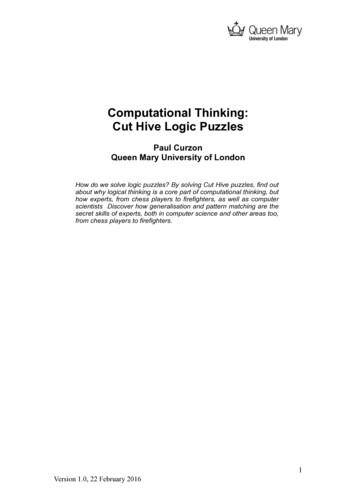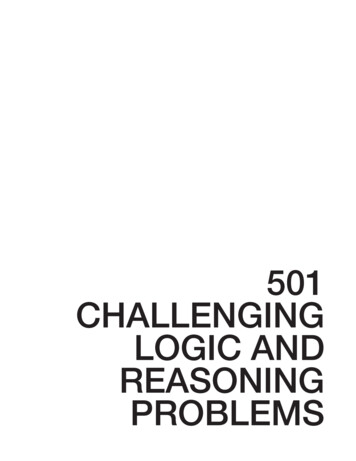
Transcription
Developing a logic model:Teaching and training guideFebruary 2008Ellen Taylor-Powell, PhDDistinguished Evaluation SpecialistEllen HenertSystems Design SpecialistUNIVERSITY OF WISCONSIN-EXTENSIONCOOPERATIVE EXTENSIONPROGRAM DEVELOPMENT AND EVALUATION432 N Lake Street, Madison, WI 53706http://www.uwex.edu/ces/pdande 2008 by the Board of Regents of the University of WisconsinSystem. All rights reserved.
Content guidePageSample logic model workshop agendasGlossary of common termsFrequently asked questionsText for learning peripheralsIce breakersKey resource listBibliographySectionPageActivitiesPage1. Getting started2. Everyday logic models11123. Program examples144. If-then relationships155. What makes up alogic model176. Activities vs. Outcomes197. Pin the card on thelogic model8. Logic model lingo20322Benefits oflogic models9. Benefits of logic models22424What doesa logic modellook like?10. Is there ONElogic model?2411. Comparing chartand flow-diagrams2512. Families or nestedlogic models2713. Cultural adaptations28111What isa logic model?217Logic modelcomponentsand language530Developinga logic model635Logic modeland evaluation2114. Card sort3015. Practice creating alogic model16. How good is yourlogic model?17. Using a logic model tofocus an yday logic models1Worksheet – Our everyday logic model2Parent Education Program3Youth Financial Literacy4Elder Nutrition5Wisconsin First Book6If-then relationships7Worksheet – Let’s practice 9Lines and arrows in logic models11About causation12Basic logic model13Program Development Logic Model14Logic model components: Definitions15Logic model worksheet16, 17Not how many worms 18Which are outcomes?19Pin the card on the logic model20Cookie baking logic model21Logic model lingo22Getting to know the language24What does the statement really convey? 26Slides2-1314-1920-2728-3334-4445-4647-50Logic models come in variousshapes and sizesTwo common logic model variationsComparing table and flow chart Building native communitiesMultiple chains and directional flowsMultiple logic modelsMulti-level systemMulti-component2829303132333435Getting started with LM development36Ideas for facilitating LM development37Where should you start in creating a LM? 40Program element cards41Logic model layout47Logic model worksheet16, 17Community collaborative case48Logic model review worksheet49How good is your logic model?51What do you (and others) want 52Parent education example questions53LM and common types of OPING A LOGIC MODEL: TEACHING AND TRAINING GUIDE 2008 by the Board of Regents of the University of Wisconsin System. All rights reserved.
Developing a logic model:Teaching and training guideLogic models help us plan, implement, evaluate, and communicate moreeffectively. Many funders and organizations require logic models. Thisguide provides activities with handouts, slides, and other resources forfacilitators to use in helping individuals and groups create and use logicmodels.The materials in this guide, based on the University of WisconsinExtension logic model format, are appropriate for beginning-level logicmodel users. At various points, more advanced concepts and materials areprovided. These are highlighted with the notation:Level 2It is assumed that participants have already engaged in strategic planningand/or spent time understanding the situation and setting priorities as aprecursor to developing a logic model.Participants can learn independently about logic models using Module 1 ofthe online course “Enhancing Program Performance with Logic Models”http://www.uwex.edu/ces/lmcourse Many of the materials provided in thisguide are adapted from this resource.While materials in this guide are ordered and clustered by section, there isno “one” way to facilitate learning about logic models. Many activitiesand examples are provided for you to choose from to meet the learningneeds of your audience. Or, create your own, based on the relevantexperience and program contexts of your learners.Brief history of logic modelsDespite the current fanfare, logic models date back to the 1970s. The firstpublication that used the term “logic model” is usually cited asEvaluation: Promise and Performance by Joseph S. Wholey (1979).Bennett's hierarchy, The Seven Levels of Evidence (1976), well-known inCooperative Extension circles, is an early forerunner of today's logicmodel. We see the antecedents and footprints of logic model thinking inmany places: private sector, public sector, nonprofit sector, internationalarea, and evaluation field. Private sector. The private sector has experienced total qualitymanagement (TQM) and performance measurement movements. Public sector. The Government Performance and Results Act(GPRA) of 1993 moved all federal agencies to focus on results andlink investments to results, not just activities. Nonprofit sector. The nonprofit sector is concerned withimproving programs to produce valued impacts. The United WayDEVELOPING A LOGIC MODEL: TEACHING AND TRAINING GUIDE2/29/2008 2008 by the Board of Regents of the University of Wisconsin System. All rights reserved.Page 1
is a frontrunner in outcome measurement using the logic model.(United Way web site: http://www.unitedway.org/outcomes/) International. Players in the international arena have usedvariations of a logic model for a long time. The U.S. Agency forInternational Development (USAID) Log Frame of the 1970s is ahistorical precedent to the current logic modeling discourse. Mostinternational donor agencies use a form of program logic forplanning and evaluation. Evaluators. Evaluators have played a prominent role in using anddeveloping the logic model. This may be why the logic model isoften called an “evaluation framework.” In fact, the origins of thelogic model go back to Suchman (1967) and Weiss (1972). Otherearly influences were Bennett's (1976) hierarchy of evidence,developed to evaluate the effectiveness of Extension programs, andWholey's (1979) evaluability techniques, developed to determine ifa program is ready for evaluation. This work was a result ofevaluators being asked to evaluate impact and finding that goalsand objectives were vague; finding that programs didn't exist orweren't being implemented in a way that would achieve theexpected results; and seeking new approaches for measuringcausality [Bickman (1987), Chen (1990) theory-driven evaluation,and Weiss (1997) theory-based evaluation]. Development and useof logic model concepts by evaluators continues to result in abroad array of theoretical and practical applications (seeBibliography).AcknowledgementsToday, many variations and types of logic models exist. The logic modelused in this guide has evolved since 1995 in Cooperative Extension at theUniversity of Wisconsin, largely in response to the GPRA initiative(Government Performance and Results Act, 1993) and interest in being alearning organization. It was originally informed by the Bennett Hierarchyof Evidence and the USAID Log Frame and has evolved in response to theburgeoning field of logic model practice. In particular, we would like tocredit ideas and materials that we have used and adapted from United Way(1996), W. K. Kellogg Foundation (1998), H. Hatry (1999), G. Mayeske(1994), McLaughlin & Jordan (1999), the Evaluation Forum in Seattle,WA., and the logic model development work done at the Center forDisease Control and Prevention.Citation format:Taylor-Powell, E., & Henert, E. (2008) Developing a logic model:Teaching and training guide. Madison, WI: University of WisconsinExtension, Cooperative Extension, Program Development and Evaluation.http://www.uwex.edu/ces/pdandePage 22/29/2008DEVELOPING A LOGIC MODEL: TEACHING AND TRAINING GUIDE 2008 by the Board of Regents of the University of Wisconsin System. All rights reserved.
Sample logic model workshop agendas1 day workshop8:308:4590 minute workshop (participants beginners)Time2:452:553:254:004:10ActivityWelcome - IntroductionsIce breakerWhat is a logic model (LM)?Getting on the same page withterminology and basic concepts –mini-lecture with slidesMaterials neededSign-in sheetPoster, markersTable talk: WHY are so manyfunders requesting LMs? Rationaleand benefit of LMQuestion on poster paper2:00Terminology – lingo game(emphasize activity vs. outcome)Lingo game(answer sheet)2:302:45ApplicationExample LM handouts. Reviewkey aspects of each to highlightsimilarities, differences, keyconcepts.10:0010:15Slides, handouts12:001:004:00Welcome, Introductions, Ice breakerLogic model : FrameworkWhat it is; Why use it; Theory of change; Causalconnections; Outcomes vs. activitiesBREAKLogic model: PracticeCompare logic models; Draw a logic model of yourprogram; Check your logic modelLUNCHLogic model: issues and opportunitiesHow, when, where do we use this?Using your logic model in evaluationWhy use a logic model; Evaluation questions; What toevaluate – whenBREAKIndicatorsLinking an evaluation plan to your logic modelWrap-up and next stepsHandout – example LMs2 day workshopLarge group: Do one together(Cookie baking example). Adherecards to poster as group calls out:input-output-outcomePoster paper – blank logicmodel; cards with tapeSmall group work. Use Parenteducation example. Distribute setsof cards; groups sort cards tocreate a LMSet of Parent Educationcards/ group answer sheetLM in evaluationTable talk – Why do we use alogic model in evaluation?Question on posterMini-lectureSlidesWrap-up, workshop evaluationEvaluation cardsDeveloping a logic model: Teaching and training guide2/29/2008 2008 by the Board of Regents of the University of Wisconsin System. All rights reserved.Day 1:Developing a logic model8:30 Welcome, Introductions,Ice breaker8:45 Logic model: FrameworkWhat is it? Why use it?10:00 BREAK10:15 Theories of changeFocus on outcomes12:00 LUNCH12:45 Logic model: PracticeCreating a logic model ofyour program2:45 BREAK3:00 Checking our models4:30 Wrap-up of Day 1;AnnouncementsDay 2:Using a logic model inevaluation8:30 Evaluation planning:focus, methods, indicators,analysis, use9:00 Engaging stakeholders infocusing the evaluationWho wants to know what?Evaluation questions10:00 BREAK10:15 Data collection methods –what to use, when12:00 LUNCH12:45 Designing your evaluation2:45 BREAK3:00 Evaluation design,continued4:00 Final wrap-upPage 3
Glossary of common termsAccountability. Responsibility to provide evidence to stakeholders and funders about theeffectiveness and efficiency of programs.Baseline. Information about the situation or condition prior to a program or intervention.Benchmarks. Performance data that are used for comparative purposes.Impact. The social, economic, civic and/or environmental consequences of the program.Impacts tend to be longer-term and so may be equated with goals. Impacts may be positive,negative, and/or neutral: intended or unintended.Impact indicator. Expression or indication of impact. Evidence that the impact has/is beingachieved.Inputs. Resources that go into a program including staff time, materials, money, equipment,facilities, volunteer time.Logic model. Graphic representation of a program showing the intended relationshipsbetween investments and results.Measure. Either quantitative or qualitative information that expresses the phenomenon understudy. In the past, the term measure or measurement carried a quantitative implication ofprecision and, in the field of education, was synonymous with testing and instrumentation.Today, the term measure is used broadly to include both quantitative and qualitativeinformation.Outcomes. Results or changes from the program such as changes in knowledge, awareness,skills, attitudes, opinions, aspirations, motivation, behavior, practice, decision-making,policies, social action, condition, or status. Outcomes may be intended and/or unintended:positive and negative. Outcomes fall along a continuum from immediate (initial; short-term)to intermediate (medium-term) to final outcomes (long-term), often synonymous with impact.Outputs. The activities, products, and participation generated through the investment ofresources. Goods and services delivered.Program. An educational program is a series of organized learning activities and resourcesaimed to help people make improvements in their lives.Program evaluation. The systematic collection of information about activities,characteristics and outcomes of programs used to make judgments, improve effectiveness,add to knowledge, and/or inform decisions about programs in order to improve programs andbe accountable for positive and equitable results and resources invested.Performance measurement. The ongoing monitoring and reporting of accomplishments,particularly progress towards pre-established goals.Qualitative data. Data in a narrative or text format.Quantitative data. Data in numerical format.Program Logic Model FrameworkInputsOutputsActivitiesPage ongDEVELOPING A LOGIC MODEL: TEACHING AND TRAINING GUIDE 2008 by the Board of Regents of the University of Wisconsin System. All rights reserved.
Frequently Asked Questions (FAQs)1. What is the right way to construct a logic model?There is no one or “right” way to develop a logic model. It all depends upon yourpurpose, how you will use the logic model (for planning, implementation,evaluation, or communications), who will use the logic model, your context andgiven resources.2. How general or specific should a logic model be?Again, this depends upon your purpose and use and the level of program you wishto portray. A logic model needs to convey what is meaningful and understandableto its users. A logic model used for implementation or evaluation purposes maybe more detailed than one used for communication. For complex, multi-level ormulti-component initiatives, several logic models may be needed.Remember, a logic model is not supposed to be an exact representa
Wisconsin First Book 6 20-27 1 11 What is a logic model? 4. If-then relationships 15 If-then relationships 7 Worksheet – Let’s practice 9 Lines and arrows in logic models 11 About causation 12 28-33 5. What makes up a 17 logic model Basic logic model 13 Program Development Logic Model 14 Logic model components: Definitions 15 Logic model worksheet 16, 17 34-44 6. Activities vs. Outcomes .
